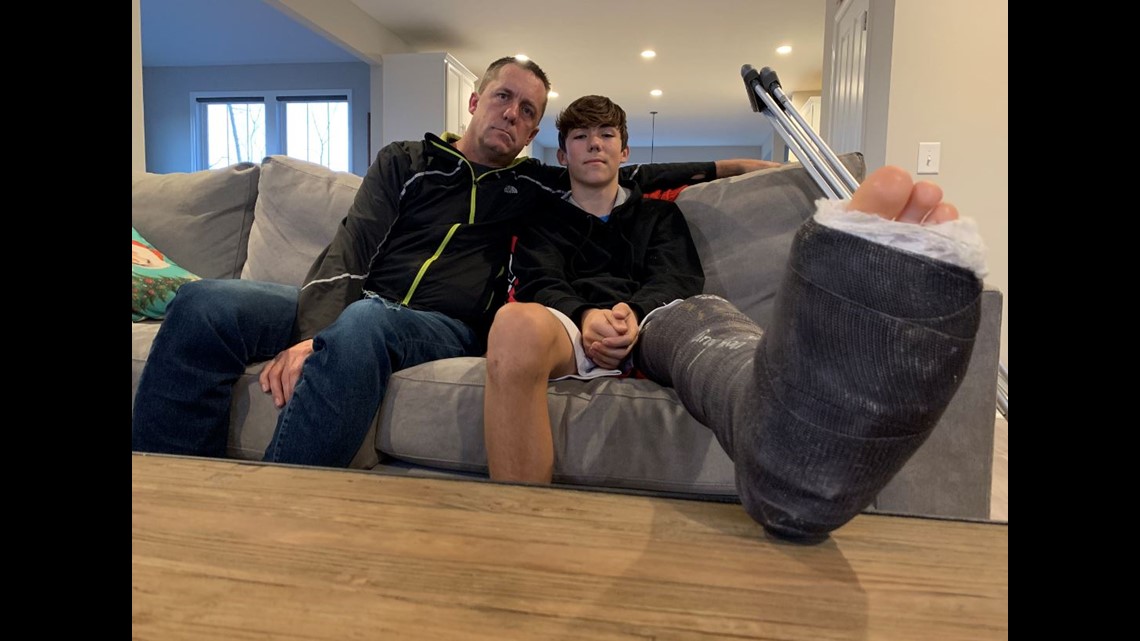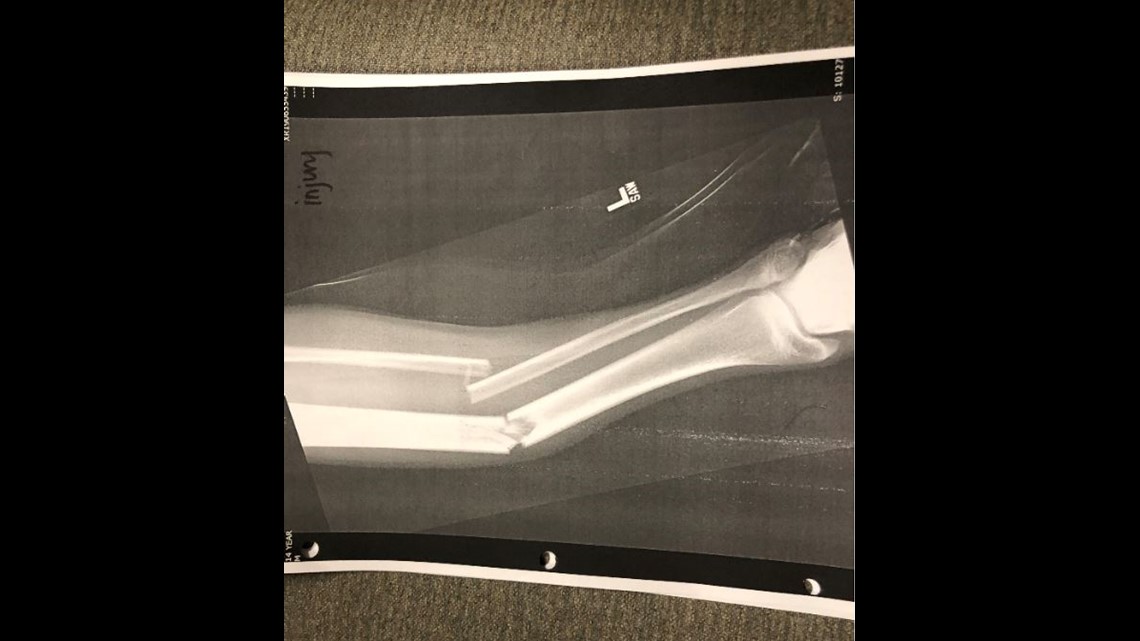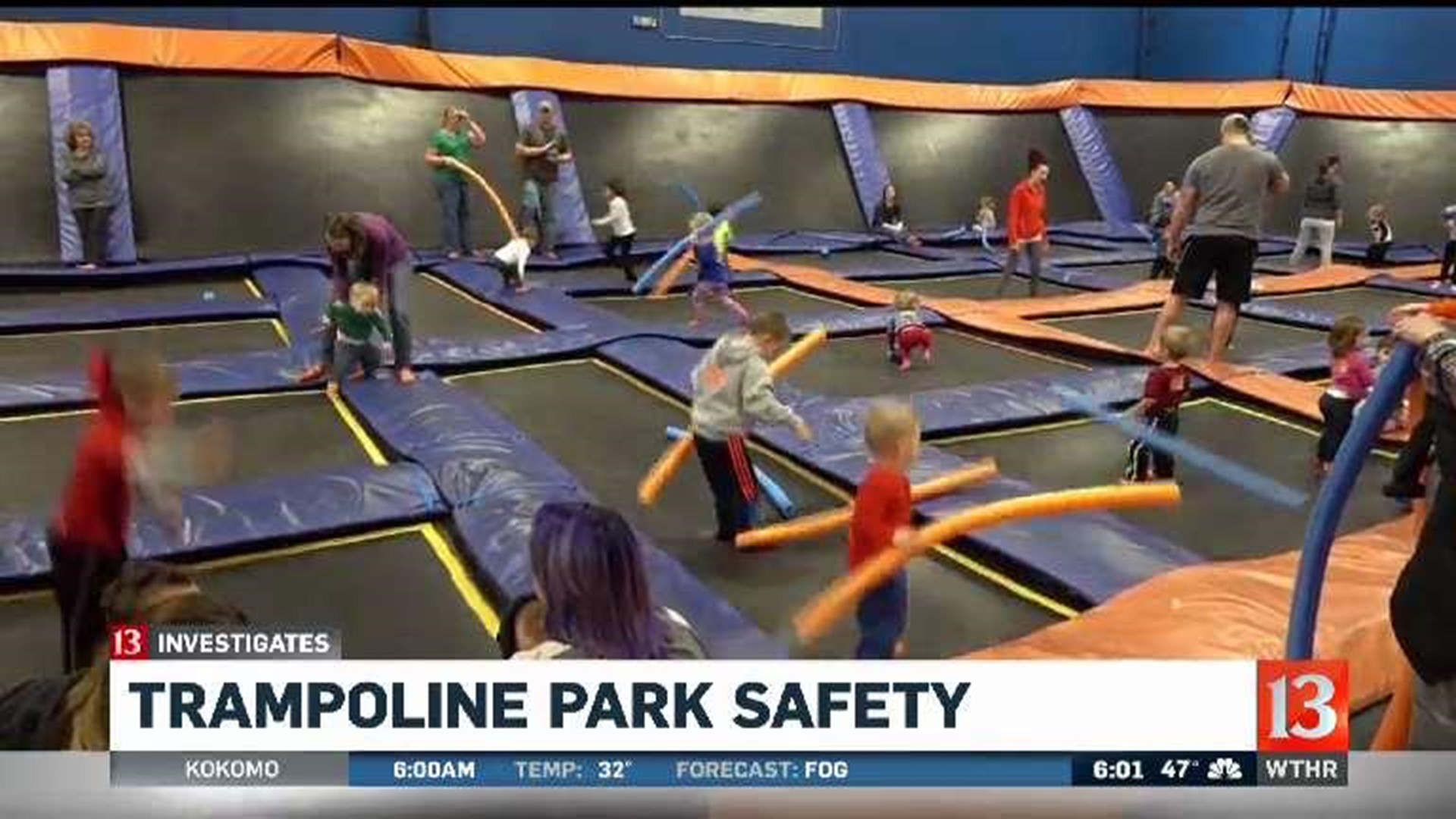INDIANAPOLIS (WTHR) — Gavin Harris is spending his winter vacation on crutches after suffering a nasty leg injury.
“It’s definitely caused a lot of pain and it's made everything I do a struggle,” said the Zionsville High School freshman.
The injury happened last month at the Sky Zone trampoline park in Plainfield. Harris said he was jumping on the trampoline and trying to dunk a basketball when an awkward landing cracked two of his leg bones in half.
“I heard it. It was like a really loud snapping noise, and at first I thought it must have been a spring in the trampoline that broke,” the 14-year-old told WTHR. “Then I looked down and saw my leg was just dangling, and I couldn’t feel anything in my feet. I couldn’t feel my toes… and about 30 seconds later is when the pain really kicked in, and it was horrible.”


Harris broke his tibia and fibula, requiring surgery to reset the bones followed by months of rehab and physical therapy. Even now – exactly one month after the injury – he is trying to make sense of what happened.
“I was just thinking how could this happen? I just thought it was something you saw on TV that was a freak accident, but after experiencing it, I'd say it's not a freak accident at all.”
Statistics obtained by 13 Investigates suggest trampoline-related injuries are far from uncommon. In fact, as trampoline parks continue to grow in popularity, so do the number of broken bones linked to trampolines and pediatricians and orthopedic surgeons say those injuries are cause for serious concern.
More than 100,000 injuries each year


Central Indiana is now home to 10 trampoline parks. WTHR obtained emergency dispatch data for those located in the Indy metro area, and the data reveals more than three dozen 911 calls this year alone for injuries serious enough to warrant paramedics. Most were for suspected broken bones.
“He’s awake. He’s screaming,” an employee at Sky Zone South in Indianapolis told a 911 dispatcher earlier this year when he requested paramedics for a boy with an apparent broken leg.
“I’m calling because my son is at a trampoline park in Indianapolis. I believe he has a broken leg … it’s deformed,” a father explained as he called 911 to report another serious injury at the DEFY Indy trampoline park.
It's a problem 13 Investigates first reported four years ago when parents contacted WTHR to report a rash of serious injuries related to trampolines. At that time, WTHR analyzed nationwide injury data from the Consumer Product Safety Commission's National Electronic Injury Surveillance System. It showed an estimated 104,691 people each year – more than 1 million people over the past decade – had suffered trampoline injuries that resulted in a visit to an emergency room.
The vast majority of those injuries (85 percent) involved children – many of them very young. Consumer Product Safety Commission (CPSC) data revealed children ages 2 to 5 accounted for 24,318 trampoline-related ER visits in 2014. A whopping 42 percent of those injuries among toddlers and pre-schoolers were for bone fractures. To put the trampoline fracture rate in perspective, government data showed emergency rooms across the United States treated seven times the number of broken bones for 4- to 6-year-olds injured on trampolines compared to those injured by playing soccer.
Those injuries prompted a doctor at Riley Hospital for Children to issue a stern warning: children and trampolines are a bad combination.


“Children should not be on trampolines. The injury rate is just too high,” Dr. Randall Loder, an orthopedic surgeon at Riley and chairman of the Indiana University Department of Orthopaedic Surgery, told WTHR in 2016. “Pediatric bone is different than adult bone. It's softer. It's more compressible. It's spongy. Pediatric bone can fail relatively easily. If the forces are just right, it can snap… I just don’t think there’s any safe age for a child to be a trampoline."
Trampoline industry responds
For this news report, 13 Investigates contacted Sky Zone, DEFY Indy and Urban Air trampoline parks to request information about their injury rates and safety procedures. None of the business returned WTHR’s phone calls.
The International Association of Trampoline Parks did send WTHR a statement. IATP spokeswoman Bethany Evans said the trade organization “takes every opportunity to communicate and recommend to our members that all optimal steps be taken to mitigate risks.” She also told WTHR that jumping on trampolines is not more dangerous than other athletic activities.
“With over 80 million hours spent jumping in trampoline parks across America this year, available data indicates that trampoline park injury rates are lower or on par with common youth sports such as soccer, basketball and volleyball, and far lower than contact sports such as lacrosse and football. In addition, we believe the health benefits such as cardiovascular, muscular, coordination, mental health and the social interaction of active bouncing far outweigh the negatives,” Evans wrote.
To enhance customer safety, IATP said it is developing educational resources for parents to explore before visiting an indoor trampoline park. And by 2021, all IATP-member parks will be required to pass a third-party inspection to continue their membership.
Pediatricians discourage trampoline use
Despite the industry’s safety efforts, the American Academy of Pediatrics maintains a strong policy statement opposed to recreational trampoline use. According to AAP’s website, “home use of trampolines is dangerous for children and should be strongly discouraged.” (The academy does not discourage trampoline use at gymnastics training centers offering age- and skill-appropriate instruction and monitoring.) That statement is based on statistics showing more than 1 million emergency room visits for pediatric trampoline injuries between 2002 and 2011, costing over $1 billion in medical bills.
Since that research was conducted, the number of trampoline parks and the injuries linked to them have jumped dramatically. AAP said between 2011 and 2014, the number of emergency room visits from injuries suffered at trampoline parks rose more than 10-fold from 600 to almost 7,000. Those injuries tend to be more serious than those experienced on home trampolines. A 2016 study cited by AAP shows “trampoline park injuries have a 1.7 times higher likelihood of requiring admission to the hospital, have a longer length of stay if admission is required and are more costly to treat compared to injuries sustained at home.”
New research presented this fall at the American Academy of Pediatrics’ national conference in New Orleans highlighted a significant increase in the number of trampoline-related fractures suffered by children from 2008 to 2017. Most notably, trampoline-related fractures accounted for more than 6.2 percent of all broken bones in children in 2017, compared to 3.6 percent of pediatric fractures that were caused by trampolines in 2008. Researchers based their findings on data collected from the National Electronic Injury Surveillance System. They identified a significant increase in the number of injuries sustained at a place of sport or recreation, such as trampoline parks.
Yet most parents are still unaware of the serious risks posed by recreational trampolines.
“It was shocking to me. I had no idea,” said Gavin’s father, Bryan Harris. “Obviously, there is an assumed risk at places like this, but there is a certain assumption it’s going to be somewhat safe.”
Trampoline park visitors are required to sign liability waivers in order to participate. At the Sky Zone that Harris visited, the waiver states “…participating in trampoline and other activities is inherently and obviously dangerous. These risks include serious physical or emotional injury, paralysis, death, damage to myself, the Child, and/or third parties … Participants may die or become paralyzed, partially or fully, through their use of the Sky Zone facility and participation in Sky Zone activities.”
The waiver also informs patrons “safety is your responsibility” and that they are not entitled to recover any money from Sky Zone if they are injured.
Gavin said he signed the form without reading all of the fine print. Even if he had, the teenager said he likely would not have done anything different.
“You don’t think much about it. I had been there before without any problems. I did have a friend who got injured there a couple of years ago, but I never thought it would happen to me.”
He doesn’t think that way anymore.
“I think the lesson to be learned is it can happen to you,” Harris told WTHR. “It should be an actual concern you really think about.”
Tips to reduce trampoline injury risk
Both the American Academy of Pediatrics and the International Association of Trampoline Parks have suggestions aimed at reducing trampoline-related injuries.
AAP recommends:
- Somersaults and flips should be discouraged. Failed attempts at these maneuvers can cause devastating cervical spine injuries, resulting in permanent disability or even death.
- Only one child should be allowed on the trampoline at a time.
- Never allow children to jump without supervision. The supervising adult should be willing and able to enforce the recommendations above and should never leave children unattended.
- Netting and other safety equipment have not been shown to decrease trampoline-related injuries. Vigilance is necessary when using any type of trampoline, even trampolines with safety devices.
- Springs should be covered with padding to avoid pinching fingers or toes and to protect against falling into the crevice between the springs.
- Trampolines should be inspected regularly for tears, rust and detached springs or pads.
- Keep ladders away from trampolines as they provide a mechanism for small children to get on the trampoline and jump without supervision.
- Homeowners with a trampoline should verify that their homeowner’s insurance covers trampoline-related claims.
- The use of trampolines as recreational structures should not be taken lightly, and parents should have an appropriate understanding of the risks. Safety precautions for trampoline use should be viewed in a similar light as those for swimming pools.
- The safest option is for families to simply not have a trampoline. However, if they choose to have one, strict rules should be set and precautions followed.
According to IATP:
- Never jump without a court monitor supervising the attraction
- Be certain to read all rules and regulations posted throughout the park
- Make sure to watch a safety video or have a safety briefing from staff
- Always be aware of your surroundings, and never jump around or near other jumpers
- If the park has a foam pit make sure the foam is at or above the level of the trampoline
- Look for the IATP membership sticker on the door

